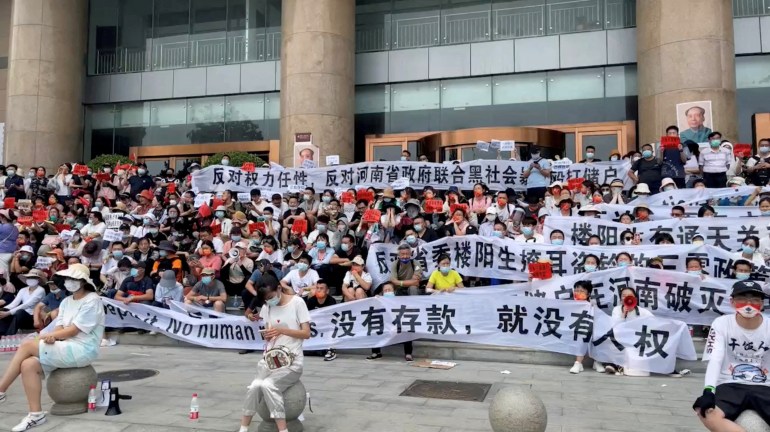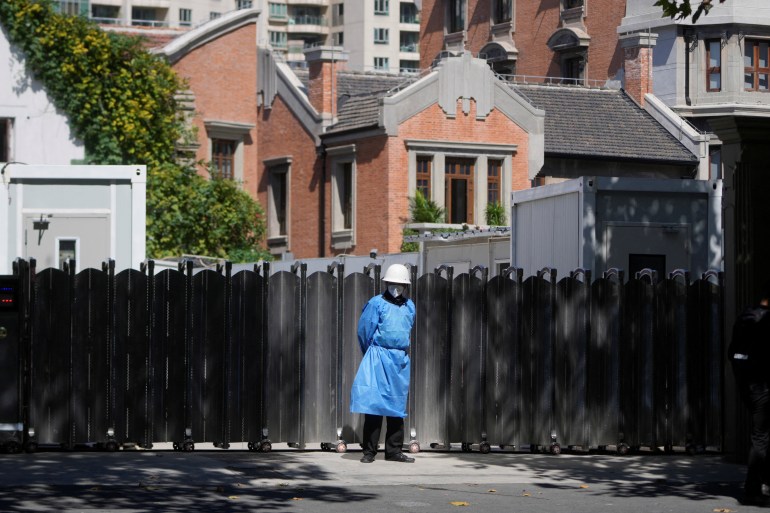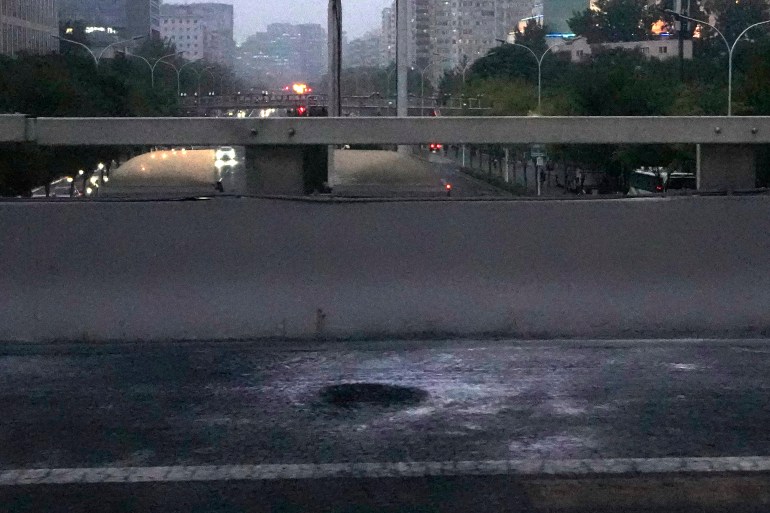A few months ago, a box was left outside the apartment door of Yu Ting Xu*, 34, in Beijing. Inside was an electronic monitoring bracelet and a requirement that he wear it at all times as part of the fight against COVID-19 in his residential area.
As he tells his story over a video call, Yu moves in the background. When she returns to her screen, she is holding the bracelet, which looks like a smart watch but has a white plastic surface instead of a screen.
“I’ve never worn it,” he said.
“I have accepted lockdowns, forced COVID-19 testing and health codes, but this feels like surveillance just for the sake of surveillance.”
The bracelet was the final straw for Yu, who is among a growing number of concerned citizens about the motivation for Chinese authorities’ expansive use of COVID-19-related technology.
“I’m afraid the COVID-19 strategy is starting to be about controlling the Chinese instead of fighting COVID-19,” he told Al Jazeera.
Just days before Yu received the bracelet, thousands of residents in central China took to social media to stage a protest outside a bank in Zhengzhou.
Many had been unable to access their bank deposits at the city’s Yu Zhou Xin Min Sheng municipal bank since April, and the bank claimed the problem was due to “system updates.”
Fed up with months of excuses, depositors planned to protest outside the bank’s headquarters. But the day before, thousands of depositors suddenly noticed their smartphones buzzing and the health codes on their mandatory COVID-19 apps turning from green to red.
Color changes typically occur when the holder has visited an area infected with COVID-19 or has been designated a close contact with someone with the virus, and means the person should immediately quarantine.
The red codes raised their eyebrows.
No COVID-19 outbreak had been recorded in the province, and the health codes of the family members who accompanied the many depositors to the protest remained green.

Beijing has said that technology such as the app and the bracelet are crucial to its zero-COVID strategy and its commitment to eradicate the virus, but red health codes in Zhengzhou and electronic bracelets in Beijing have contributed to increasing skepticism about the government reasons.
protection that deals damage
When the health code system was implemented in early 2020, human rights groups including Human Rights Watch warned that such digital tools risked violating the human rights of any Chinese citizen with a smartphone.
In the first two years of its operation, those early warnings were largely drowned out by thunderous applause at the apparent success of the zero COVID policy. While many Western countries were reeling from one chaotic nationwide lockdown to the next, Chinese authorities were able to keep most of China free of COVID-19 with targeted lockdowns using digital tools to prevent the infected or potentially infected from spreading the virus.
Today, however, the roles are largely reversed.
While most of the world has used vaccination as a way around coronavirus restrictions, China is stuck in a cycle of unrelenting lockdowns in a relentless quest to end all COVID-19 outbreaks. Despite the wide availability of COVID-19 vaccines and the associated decline in death rates, Beijing’s zero-COVID policy remains firmly in place with no end in sight.
The Chinese government defends the policy as a well-intentioned strategy to protect people.
But prolonged lockdowns in cities like Shanghai have brought with them reports of food shortages, family separations and even the killing of the pets of quarantined patients. In mid-September, there was outrage when a bus carrying people to a COVID-19 quarantine center crashed, killing 27 passengers.

The accident directly fueled the ongoing discussion in Chinese society about the cumulative costs of the government’s coronavirus policy.
“It is the government’s zero-COVID strategy that is killing us, not COVID-19,” declared a Weibo user after the accident.
His post was quickly removed by censors.
On Thursday night, two protest banners were hung from a Beijing overpass questioning coronavirus controls and, in an even more unusual move, Xi’s leadership.
Social media posts showed plumes of smoke rising into the air, but in the virtual and real worlds all evidence of the event was quickly removed.
More intrusion, less support
Han Wu*, 37, from the southern city of Guangzhou, was one of many Chinese Weibo users who expressed outrage after the incident in Zhengzhou. Like Yu in Beijing, he too believes that the authorities have gone too far in their quest for zero COVID.

Han was forced to leave his home and move to one of the government’s quarantine centers for 14 days after testing positive for COVID-19 in late June.
“When I got back to my apartment, I could see that the door had been forced open and my things were scattered all over the place,” he told Al Jazeera, before turning on his phone’s camera to show marks and cuts outside. from her door as evidence of the forced entry.
Han later learned from local authorities that they had entered his apartment to disinfect the rooms and make sure no one else lived there. They were necessary precautions, they told him.
“I support containing COVID-19 infections, but I do not support government raids or violations of privacy,” he said.
Lin Pu is a scholar of digital authoritarianism and Chinese influence at Tulane University in the United States.
He explains that it used to be so-called terrorists, separatists, criminals, and political activists who felt the Chinese authorities’ ability to oppress, but the zero-COVID policy had exposed the generally more apolitical middle class to the strong arm of government.
He says discontent could lead to further abuse of the system.
“It is quite possible that the digital tools initially used for COVID control will increasingly be used for social control if dissatisfaction continues to rise,” says Lin.
“In turn, this can create a feedback loop where dissatisfaction with the COVID strategy tempts authorities to use digital tools to ensure social control, leading to further dissatisfaction.”
‘No revolutionary’
The unease over COVID policies comes at a time when the need for stability is paramount for China’s ruling party.
The 20th Congress of the Chinese Communist Party (CCP) is scheduled to start on October 16 and President Xi Jinping is expected to win an unprecedented third term, making him the longest-serving party leader since Mao Zedong. .
The congresses are among the most important political events in China and are held only once every five years.
“China is facing a series of complex challenges at a time when the CCP and Xi Jinping need to make China appear prosperous and harmonious,” said Christina Chen, who specializes in Chinese politics at the Taiwanese think tank INSR.
The zero-COVID strategy is also hurting the economy, with growth slowing in decades, youth unemployment at a record 20 percent, and a distorted housing market where thousands are refusing to pay mortgages on incomplete homes, while a The decades-long building frenzy has left more than 50 million homes unoccupied.
“China must appear stable, and the political projects associated with his presidency, such as the zero-COVID strategy, must appear as indisputable successes to legitimize him in a third term,” adds Chen.

Looking ahead to Congress, COVID cases are on the rise and new variants have been discovered. While no deaths have been reported since April, the government continues to stress its commitment to ‘zero-COVID’ despite resentment among the general public over harsh restrictions and regular testing.
Back in Beijing, Yu admits that politics has made her more suspicious of the authorities.
“I’m not a revolutionary,” she said as she closed her fingers around the electronic monitoring bracelet on her palm.
“I just don’t want to be monitored and exploited.”
When asked what she would do if forced to wear the wristband, she stands up and pushes her chair back.
“I’ll show you.”
He takes a few quick steps to an open window at the back of the room and throws the bracelet out into the night.
* Yu Ting Xu and Han Wu’s names have been changed to protect their identities.




